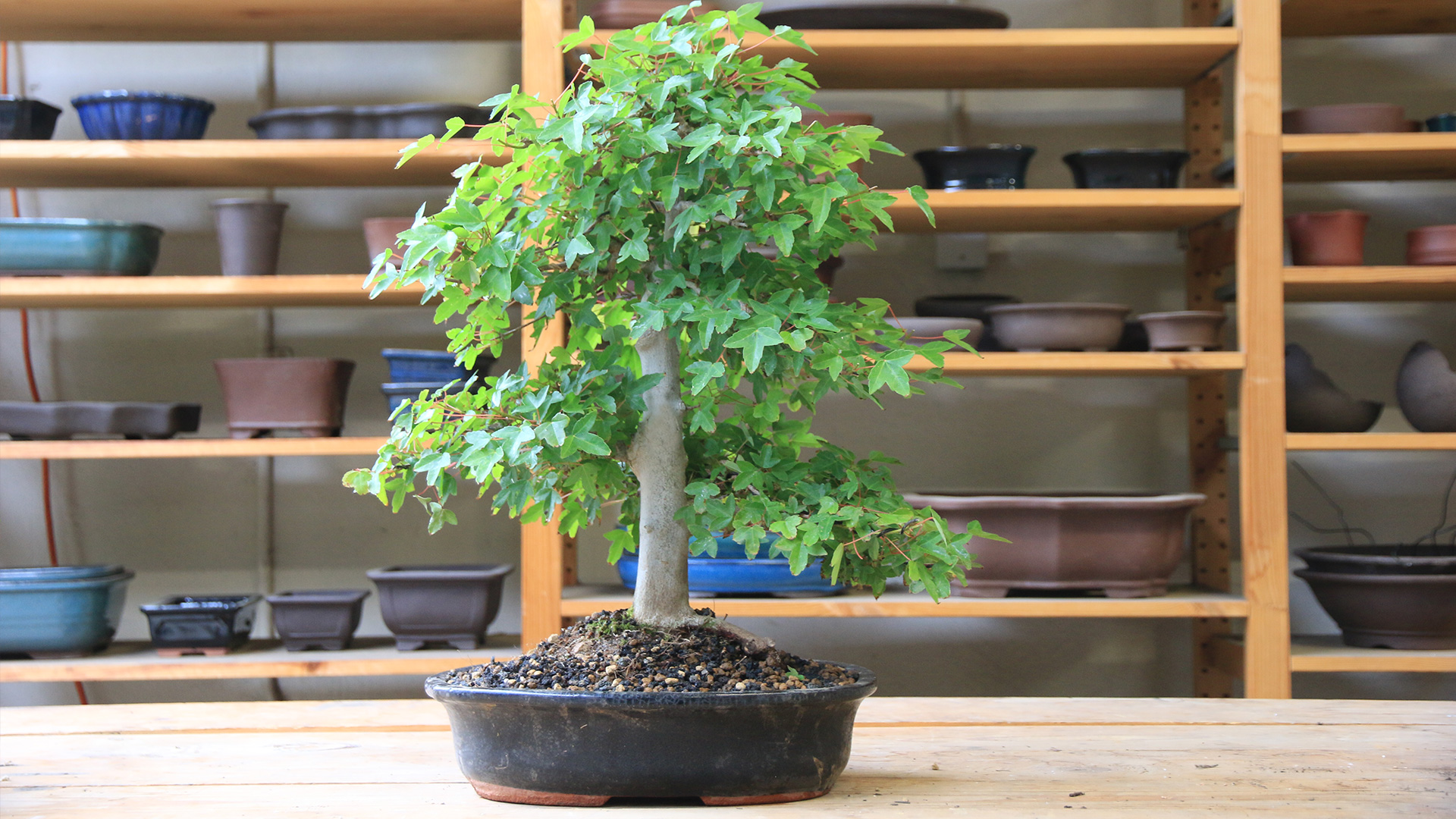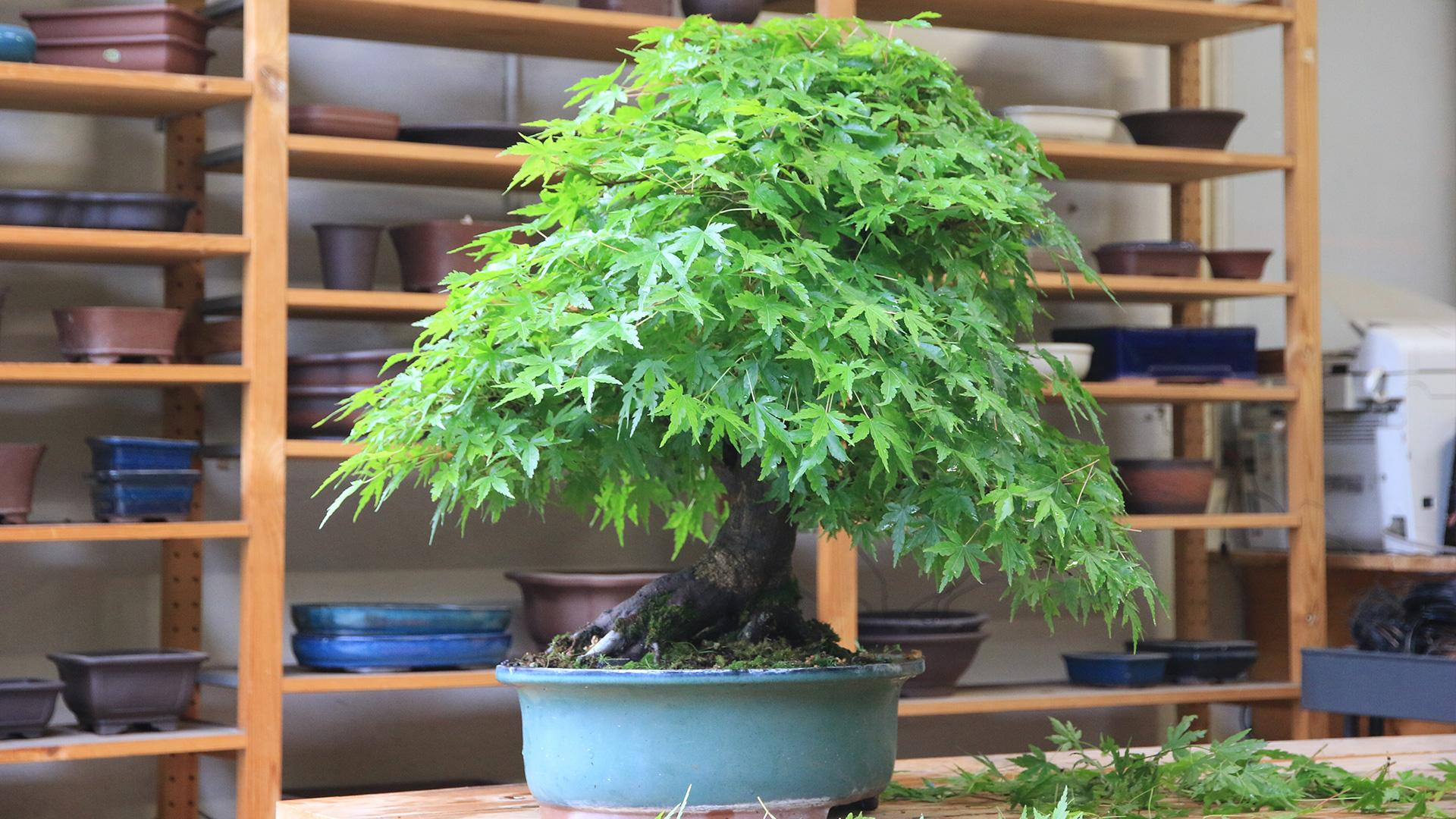Maple bonsai trees are one of the most popular species of bonsai. This is most likely because of the visual changes that the maple bonsai tree goes through with each season. During the winter, the maple bonsai trees will lose all their leaves, leaving behind a beautiful winter silhouette. In the spring, bright foliage will emerge from the tree’s nodes. During summer, the maple’s foliage will strengthen, with branches beginning to extend outwards. In the fall, many species of maples will begin to turn yellow and orange. The leaves will eventually fall off during dormancy in the winter.
Maple trees are extremely resilient to a variety of climate conditions. They can also tolerate very aggressive root work. However, the foliage on maples can be finicky. Below are some tips and techniques on how to maintain beautiful leaves on your maple, even if they are not placed in the most ideal conditions.
Common Maple Bonsai Species
There are hundreds of cultivars of maples each with their own colors, leaf shape, growing patterns, and tolerance to climates. Many of these species can be used for bonsai.
- Japanese Maple (Acer Palmatum) – Available in Green and Red Varieties.
- Trident Maple (Acer buergerianum)
- Full Moon Maple (Acer shirasawanum)
- Acer Palmatum ‘Kotohime’
- Acer Palmatum ‘Shindeshojo’
- Acer Palmatum ‘Kiyohime’
- Acer Palmatum ‘Sharps Pygmy’
What we love about Maples
- Seasonal Color Changes
- Leaf Shape
- Vigorous Growth
- Winter Silhouette Dormancy


Lighting
Maples do best in outdoor settings with natural sunlight. Proper lighting will enable your tree to push stronger growth. Is is important to thin and prune excessive growth on your maple to continually let in light. During the sunnier months, leaf scorch can be also caused if conjunction with windy conditions and improper water pH levels.
Watering & pH Levels
Maples do very well with daily watering. However, the most important aspect to maples is providing proper pH levels. Maples enjoy more acidic conditions (-7.0) rather than alkaline (7.0+). Depending on your area, your water levels may already be well suited for maples. However, if you live in an area with more alkaline pH levels, you may experience some leaf scorch. Adjusting your soil mix to more acidic ingredients can help with this issue, such as peat moss.
Salt levels should also be monitored in your water. Salt build up can cause leaf scorch to occur. A well draining soil that is leached occasionally will help prevent salt build up in your soil. Soil amendments can be used as well.
Maintaining proper pH for a maple can do wonders for the health of your tree. Adjusting your soil mix or water can help to create the ideal setting for your maple bonsai.
“Maintaining proper pH for a maple can do wonders for the health of your tree. Adjusting your soil mix or water can help to create the ideal setting for your maple bonsai. “
Fertilizing
Fertilizing can help your tree grow much quicker as well as help it protect itself from insects, pests, and diseases. Slow release granules work extremely well with Maple bonsai. Once placed on your the topsoil of your tree, the granules will slowly dissolve with every watering. The fertilizer granules will break apart and provide nourishment to the tree’s roots over time.
Once the granules or tablets have dissolved you can add more to continue feeding your tree. We recommend feeding your tree from Spring to Fall, scaling back during the Winter. Follow the instructions for the fertilizer to prevent overfeeding and burning of foliage. Over fertilized trees are at risk of burned leaves and possible death if used incorrectly.
Remember that if your tree is in recovery for other reasons such as pests or underwatering, do you use fertilizer until your tree is no longer stressed. Fertilizing a sick tree may cause it to die.
Temperature Requirements
Maples can survive in many climates, even hotter climates. Typically the heat itself is not the issue but rather the other conditions that accompany the heat, such as drier winds or sunny spots. Dry winds can cause leaf scorch and can completely dry out your maple if left unchecked.
An easy solution is to protect your tree from windy conditions by placing it in a spot in your garden where wind exposure is limited. Creating some shade or moving your maple bonsai tree to a shadier location can help protect the leaves from the sun.
Pests & Diseases
Common issues with Maples include the normal pests that often attack other trees. These include aphids, beetles, and leaf eating insect. Fungus gnats can also pose a problem if soil conditions are too damp.
To prevent insects from harming your tree, we recommend preventive spraying with the use of neem oil or year round oil. Applying this before the active spring insect season will prevent outbreaks. However, they can also be killed with Neem oil or simple diluted household dish detergent. The key to stopping the cycle of bugs is to spray 7 days after the first application. This will eliminate any newly hatched eggs.
Fungus issues can be a problem. If you see a layer on the surface of your trunk or branches or discoloration in your leaves, you may have a fungus issue. Proper air circulation will correct this issue. However, fungicides can also be used to kill the fungus.
Remember: Healthy trees will naturally fight away pests and diseases as well so keep your tree well hydrated and fed and your tree can natural fight away issues on its own.
Pruning and Training
Maples are great for enthusiasts of all levels due to their ease of pruning. Maples enjoy pruning in late winter, right before the spring flush of growth. This is a great time to prune because there are no leaves on your tree at this time (due to dormancy). This makes it very easy to see the branch structure and make appropriate cuts.
Maples bud out of the nodes on the branches and trunk. These are very easy to identify as they appear as lines that circle the outside of a branch or trunk. Buds will appear at these lines. The internodes are the segment between the lines (nodes). To prune your maple, just make the cuts on the internodes. Buds will appear at the nodes beneath the cut internode.
A simple trick to compact the foliage of your maple is to simply cut longer internodes. By doing this, the leaf growth will appear closer together on the branch rather that skip a large segement if the internode is too long.
By combining this process of pruning with the clip and grow method of directional pruning, you will be able to create pad layers and ramification on your maple bonsai.
Wire can also be used to bend branches down or to fill spaces. To learn more about wiring and how to wire an individual branch, watch the video here. However, maples can be trained without wire making them great trees for enthusiasts of all levels.
Defoliation
We recommend defoliating your maple tree in the summer. There are many benefits to doing this. Defoliation will create better airflow, and better sun penetration. However, defoliation also has many benefits to the leaves themselves. Defoliation can reduce the leaf size on your maple bonsai making it look more proportional. Leaves that are scorched can also be cut off, allowing for fresh stronger leaves to take its place.
To defoliate your tree, simple use your shears to cut the leaves off your tree. Make the cuts on the petioles, the small stalk that connects the leaf to the stem. The remaining petiole will wilt and die off. A few weeks later, new growth will appear all over your tree at the nodes.
“There are many benefits to defoliation. Defoliation will create better airflow, and better sun penetration. However, defoliation also has many benefits to the leaves themselves. “
Repotting
Maples can be repotted during spring for highest success rates. Avoid winter repotting as colder temperatures, as once the tree enters dormancy, the tree’s roots will not grow making it more difficult for recovery. During repotting, we recommend trimming off older roots to promote new growth. Repot your maple as the tree outgrows the pot. Depending on the growth rate, this can be every 2-3 years.
For more details on repotting your bonsai tree, view our video here.




